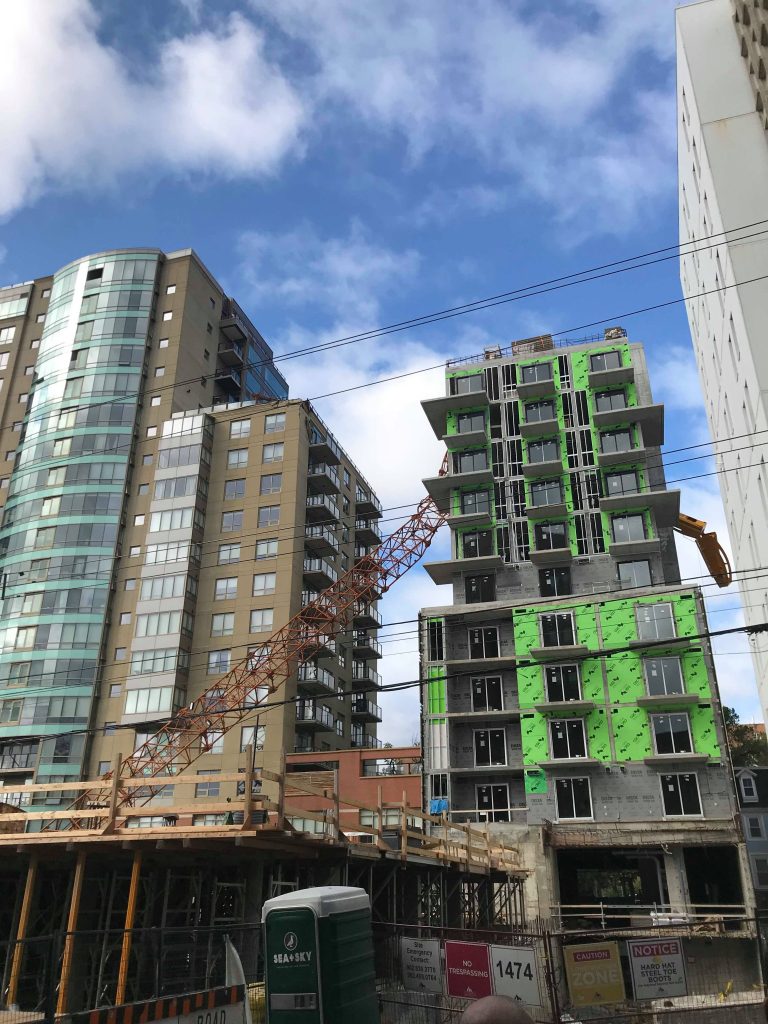
Features
Cranes
Safety & Risk Management
Halifax collapse lawsuits continue
August 23, 2021 By Matt Jones
 Image: Brendan MaGee
Image: Brendan MaGee While much was made of how the clean up and removal dragged on for weeks after the 2019 tower crane collapse in Halifax, the legal proceedings resulting from the collapse could drag on much longer.
As the construction company’s lawsuit against the owner and operator of the crane continues, business owners impacted by the collapse have shifted strategies from a class action lawsuit to a mass tort.
Fares v. Lead Structural Formwork
The lawsuit filed by Fares Construction and W.M. Fares Family Inc. against Lead Structural Formwork alleges that the crane “had suffered from a variety of structural defects which included, without limitation, rust, corrosion, breaks, splits and cracks in the steel components intended to give it its vertical, compressive, tensile, and torsional structural integrities, and broken, cracked, and deficient welds in those same steel components.”
Lead Structural Formwork’s defence stated that the company had followed instructions from the Fares companies and accused them of contributing to the collapse through negligence, the design of the apartment complex itself and that the crane needing to be at such a high elevation exposed it to stronger winds.
The Nova Scotia Department of Labour’s investigation determined that welding failure was the likely cause of the collapse.
Businesses seeking damages
Attorney Ray Wagner, who is representing the affected businesses in their suit, says the decision to move to a mass tort was made as new potential defendants emerged, including engineering firms that had been involved.
In a mass tort, all plaintiffs, often from the same geographic area, are still treated as separate individuals, as opposed to class action suits where all members are treated as one plaintiff. Wagner notes that while his plaintiffs may be involved as part of discoveries, document disclosure and other functions, moving to a mass tort likely puts their suit in a secondary position to the suit between the construction and crane companies.
“There are other, bigger players, in terms of their finances, and that will likely be taking more of a lead,” says Wagner. “We’re not dropping the litigation, but we probably won’t be leading it as we started to appear to be when we were doing the class action.”
The Nova Scotia Department of Labour’s investigation determined that welding failure was the likely cause of the collapse.
Michael Smith, co-owner of Twiggz shoe store and one of the plaintiffs in the mass tort, says that businesses like his were left with little support following the incident. Business interruption insurance, he says, was unhelpful due to the technicality that the crane had fallen on another building even though owners and customers were unable to access their businesses for some time.
“It turns out, none of this was covered,” says Smith. “What we got was a percentage of our profits, but it’s not profits I care about, it’s operating costs – power, labour, rent, the cost of goods.”
Smith says this incident should drive a conversation with the government about supports for businesses in such situations, such as a bond that could be used to support smaller companies in the interim.
“We need a cleaner mechanism,” says Smith. “We can’t allow this big Hunger Games–like legal battle at the back end. That’s not how it has to be. That just marginalizes the most vulnerable of the group. The last to get paid and they have the least means to litigate. If that’s what we’re going to do, it’s not a fair and balanced society if it comes down to rights for the mighty.”
Smith noted the possible need for a review of standards for how and where cranes are erected, as tall towers in Halifax can create a wind tunnel where wind speeds are greatly increased. Smith was also critical of Mayor Mike Savage’s response to the incident, noting that he had never visited with the impacted businesses.
“You’d think by talking to business owners, you may have learned something about how complex recovery efforts work, which could have made you more aware of how to prod your bureaucracy to do better. There’s the Halifax Wanderers soccer club – any time they want to do promotion, the mayor is on camera wearing their shirt.
“But a crane falls and nearly kills people and destroys businesses and livelihoods? Nothing. He’s a great mayor but no one is perfect. You’ve got to do the work.”
The office of Mayor Savage did not respond to a request for comment.
_____
Matt Jones is a freelance writer who regularly contributes to Crane & Hoist Canada. This article appears in the September/October issue.
Print this page